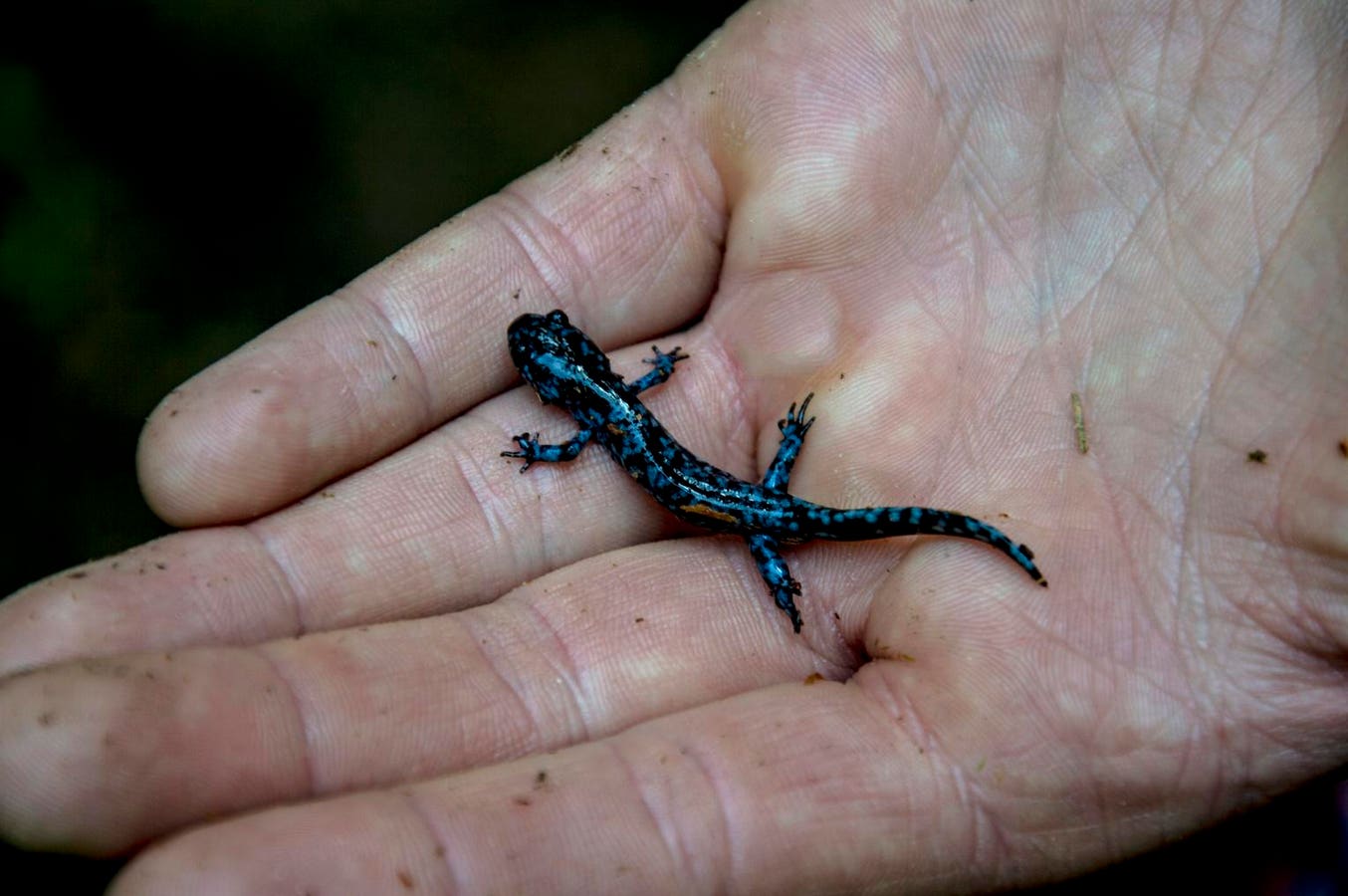A blue-spotted salamander.
Two underpasses costing $330,000 in the Lake Champlain Valley are a model effort showing how a Vermont community rallied behind thousands of tiny salamanders scurrying over the road yearly to safeguard the wildlife migrations.
“If you tell somebody an eight-inch long, purple and yellow salamander will come out of the ground in the thousands every spring and they’ve never seen it before, most people will tell you that you’re crazy. And yet, that’s exactly what’s happening every year,” said Jens Hilke, conservation planner at Vermont Fish & Wildlife Department.
A salamander in the town of Monkton pauses while crossing the road this spring in Vermont.
Most amphibians in Vermont need to live in both dry lands like forests and wetlands separated by terrain for two seasonal migrations.
“Every spring, stunning numbers of frogs and salamanders migrate from their terrestrial overwintering habitats to their aquatic breeding habitats,” explained VTF&W herpetologist Luke Groff.
Spotted salamander.
These predictable migrations to seasonal habitats enable ecopassages to be highly effective for intercepting and guiding the creatures through safer passageways.
“There’s a migratory path that has to happen seasonally. That’s highly synchronous, resulting in many, many animals making that migration simultaneously. And yet those animals outside of that time of the year are extremely difficult to find. They’re underground, they’re not visible. They’re under rocks and logs. They’re dormant for many, many months hiding out in the cold winters, especially here in Vermont,” said Brittany Moser, assistant professor at the University of Vermont’s Rubenstein School of Environment and Natural Resources.
Noticing action was needed to protect the salamanders from being decimated under tire wheels along a main road, Vermont locals in Monkton decided to safeguard the wildlife there.
Vermonters Rally to Save Native Salamanders from Extinction
Eastern red-backed salamander that is found in Vermont.
The community around Monkton is home to just over 2,000 people and many forest area amphibians. It sits in picturesque Addison County, nestled in the Lake Champlain Valley between the Adirondacks and Green Mountains, just over an hour’s drive east of Montpelier.
The community and members of the Lewis Creek Association and the Monkton Conservation Commission engaged in fundraising and received grants from the Vermont Agency of Transportation and VTF&W to create an amphibian crossing. They wanted to offer protection for large numbers of salamanders being killed while crawling across Moncton Road during their annual treks in the spring and fall.
Vermont is home to many different types of rare and common salamanders that can live for 20 years. Some are only three inches long. Others can grow up to six inches in length. The state has the blue-spotted salamander that grows no more than five inches and consumes beetles, earthworms, mites, mosquito larvae, spiders and slugs. From from three to five inches long, the Eastern red-backed salamander is the color of red bricks except for its grayish, granite-colored belly. Vermont also has four-toed salamanders and lots of frogs.
A Spring Peeper.
One common frog, also prone to being run over, is a minuscule light brownish Spring Peeper. The from is from one to two inches long and named for the peeping sound it makes while exhaling.
Side of the Monkton amphibian crossing shows boards to guide wildlife through the culvert underpass … More
Funding was raised to create two culvert tunnels with a concrete fence/wall on both sides. The wall was built a few feet high to keep amphibians within safe passage areas to guide them to the other side of the road. When they reach the wall, they can walk alongside it since it is too high for many to climb.
“Hopefully they choose the right direction. If they choose the wrong direction, they get turned around. They come back and then they go through the structure into the wetland. Then they spend the summer in the wetland. In the fall, they do it in reverse. In terms of the salamanders, it’s about a movement of perhaps 600 feet. And it [the spring migration] happens on the first rainy nights above freezing every year,” Hilke said.
The tunnel floors must be dry and moist. Dirt is placed inside to ensure there is no running water. Above the tunnels are metal grates built into the road to allow for moisture and moonlight to help the creatures along their way. The grates were designed to stay in place when passed over by snowplows.
Grates allow sunlight and moisture to pass through the culverts. Light is critical to help wildife … More
Moser underscored that even though the migration area may be viewed as short distance of 600 feet that journey is arduous for two-inch and five-inch creatures.
“When you actually scale it to the size of the organism, it’s a pretty epic migration for a critter of that size to make, especially given the terrain and the obstacles like the road,” she noted.
The inside of the culverts is a simulated natural environment with logs, rocks, flat objects and other debris where salamanders can rest during their migration.
Before and After Metrics Tell of Success
A salamander stops in the middle of the Monkton road and is in danger of being run over.
Moser worked with Matthew Marcelino (a herpetologist and quantitative ecologist who recently earned his doctorate degree at University of Vermont) on a key study measuring the effectiveness of the Monkton amphibian crossings.
A unique aspect of these crossing is data was collected about amphibian mortality rates before and after underpass construction. Moser noted that many wildlife sustainability projects move quickly once funding is obtained without capturing mortality data before construction to demonstrate effectiveness.
The numbers in Vermont tell a story of success. Before the Monkton crossing was built there were 1,000 amphibians killed on the road during two spring nights, Marcelino noted.
“After the construction of the underpasses, we noticed there was an 80% decrease in total amphibian mortality. So that’s literally saving 800 of those amphibians, which is a huge number. If you think about if that was mammals or birds, that number alone really shows their efficacy [of the road culverts],” he added.
Researchers also probed to determine if the crossings helped amphibians that could climb up over the concrete walls such as spring peeper frogs and gray treefrogs.
Amphibian Deaths Prevented due to Monkton Wildlife Crossings
Data indicated a 73% drop in the number of climbing amphibians during migration due to the tunnels. Which Marcelina called a “huge” amount in those creatures saved from being run over on the road.
The culverts are also providing safe conduct for other wildlife seen on cameras such as raccoons, bobcats and bears.
A black bear (left) and a bobcat (right) are captured on video using the Monkton amphibian crossing … More
Moser said it is important for transportation planners to realize they can incorporate wildlife crossings into existing roadway projects to lower costs of creating standalone safe animal passages and making travel safer for people and wildlife at the same time.
“There’s a benefit to knowing about these things and having them on the radar and to be able to work them into existing road updates,” she added.
Amphibians More Likely to Be Extinct from Road Kills
A salamander attempts migrate over the road pavement at night without using the Monkton wildlife … More
Road kills can have a larger impact on salamanders and other amphibian populations because of how they reproduce. In the case of Vermont’s salamanders, they are leaving their winter hibernation to reproduce across the way in marshy areas with water. Once hatched in the water, the young ones must migrate across the road to the dry land to live during colder winter months.
“For some of these species, the [roadway] mortality is a huge impact on population viability if we’re losing these animals that are of reproductive age. If they’re moving, it’s because they’re moving to reproduce. Now, we’re not just losing them. We’re losing their entire reproductive contribution for the year, which could be, depending on the species, many tens or hundreds of eggs that they’re contributing,” Moser said. “So these underpasses, they’re there all year round and supporting both directions of migration—adults on the way to the breeding pond and then juveniles as they come up onto land.”
Like salamanders, turtle populations can be severely impacted by being run over while trying to cross roads. “Certain turtle species, for example, are very late to sexual maturity. So you can have just a few hits of female turtles and wipe out an entire population with just a few turtles hit on the roads. Our populations of reptiles and amphibians are in danger,” Hilke noted.
A cost benefit analysis of wildlife crossings for amphibians, in particular, should consider the endangerment of entire populations due to road mortality.
“That’s different than thinking about deer or moose. We’re not going to lose a whole population. We might lose an individual animal, but the population of those larger animals will remain intact. With reptiles and amphibians that is not the case,” Hilke said. “It’s basic ecology. The whole system is interrelated. If we begin losing some of our biological diversity, the threat is to all of our biological diversity.”
Another point to consider is that larger animals have bigger home ranges for migration and aren’t concentrated in small corridors like amphibians. Also roads are often constructed between the dry and wet amphibian habitats.
“They ultimately become bisected by these roads, which leads to [population] fragmentation. That’s one of the reasons why it’s so important to protect amphibians and build these structures because we are perhaps impacting them more than other species because of the sensitivity of their life cycles. A very high proportion of their population takes that same migratory corridor. With larger animals, not all the deer are passing right in a 100-meter section of road, whereas in some locations that is really happening with amphibians. They’re highly concentrated,” Moser said. “The only good news is their migration tends to be at night when traffic is a little less.”
A Showcase Project
Views of the side wall (left) to guide amphibians to the tunnels and car crossing over one of the … More
One special factor about the Monkton wildlife crossing that makes it “so great and a model for other states and countries is that it was driven by local communities and organizations,” said Groff. He also commended the project for having a scientific foundation with before/after data as well as being financially supported by donations from people as well as government grants.
The Monkton Road amphibian crossings have been presented at an international conference and across the Northeast as a model of an innovative and successful wildlife infrastructure crossing project.
Hilke is working with other Vermont towns to create similar wildlife crossings. A first step, he says, is to collect wildlife mortality data at potential infrastructure crossing locations. A key way to obtain funding for such projects is to demonstrate significant roadway death rates for wildlife, especially rare species.
In Vermont and other areas along the Eastern coast, Hilke says underpasses can provide more effective wildlife crossings that overpasses especially due to flooding related to climate change.
Blue-spotted salamander.
“In our context, we can meet multiple objectives like allowing for floodwater and allowing for aquatic and terrestrial passages by appropriately sizing our gray infrastructure. As we think about climate adaptation, this gray infrastructure is a solution that works for society and works for our ecology,” Hilke said. “The power of Monkton is in the story and exciting people in Vermont and around the Northeast, and hopefully even around the world, that we can have a transportation system that works effectively for the traveling public and also stewards our wildlife. It’s not an either or. We can have both.”








